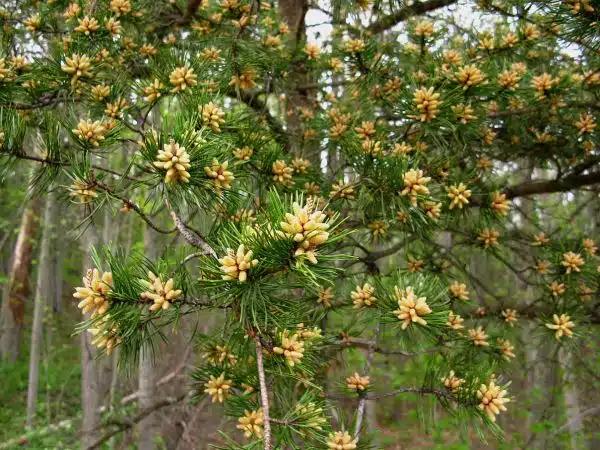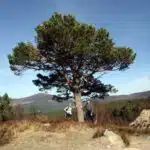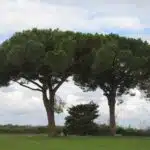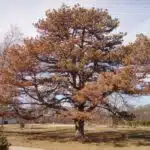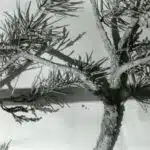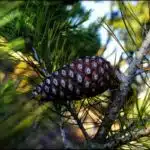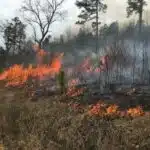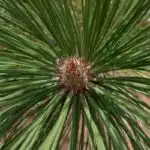The Virginia pine tree, Pinus virginiana, is a native evergreen species in the eastern United States. It is commonly found from Florida to Maine and westward into the Appalachians. The Virginia pine can grow up to 75 feet tall and has an attractive conical shape with short, stout branches that are covered in needles. As an arborist or tree expert, it is important to understand how to properly grow and care for Virginia pine trees.
Understanding the specific needs of the Virginia pine is essential for its optimal growth and longevity. This article will provide a comprehensive guide on how to cultivate healthy and thriving Virginia pine trees. From planting tips to pruning techniques, we will discuss key elements of care that will ensure your Virginia pines reach their full potential. Whether you are a homeowner looking to add some greenery to your property or a professional landscaper seeking knowledge on tree maintenance, this guide will offer valuable insights on how to grow and care for these majestic trees.
Understanding The Virginia Pine Tree
Imagine walking through a forest trail and seeing a tall, slender tree with reddish-brown bark and long needles. It could very well be the Virginia pine (Pinus virginiana), which is native to the southeastern United States. These trees can grow up to 60 feet tall and have a conical shape when young, but flatten out as they age. One of the most unique characteristics of the Virginia pine is its ability to tolerate poor soil conditions, making it an excellent choice for reforestation projects and erosion control.
Virginia pines have several distinct growth patterns that differentiate them from other pine species. In their early years, they are characterized by having short branches that spiral around the trunk. As they mature, their branches become more horizontal and grow in whorls around the trunk. The needles of Virginia pines are usually about 1-3 inches long and come in bundles of two, which distinguishes them from other pine species that typically have needles bundled in threes or fives.
Understanding the unique characteristics and growth patterns of Virginia pines is crucial in determining where to plant them and how best to care for them. Arborists must take into account factors such as soil type, sunlight exposure, and moisture levels when selecting sites for planting these trees. With proper site selection and preparation techniques, Virginia pines can thrive for decades, providing environmental benefits such as carbon sequestration and wildlife habitat.
Site Selection And Preparation
Understanding the Virginia Pine Tree is essential before growing and caring for it. This tree species is native to the southeastern United States and has a conical shape with dense foliage. It grows up to 60 feet tall, making it an excellent choice for landscaping needs, windbreaks, or privacy screens.
Soil requirements are critical when planting Virginia Pine Trees. The ideal soil type for this species is well-drained, acidic soil that ranges between pH 4.5-6.0. Before planting, make sure to amend the soil with organic matter such as peat moss or pine bark if necessary. Soil compaction can also be a problem; therefore, it’s essential to avoid heavy machinery near the planting site.
Sunlight exposure is another vital factor in growing healthy Virginia Pine Trees. These trees prefer full sun exposure but can tolerate some shade during its early stages of growth. However, too much shade can lead to stunted growth and poor foliage density. Therefore, it’s crucial to choose a location that provides at least six hours of direct sunlight daily.
Choosing the right Virginia Pine variety is crucial in ensuring successful growth and longevity of your tree(s). There are several varieties of Virginia Pines available in nurseries and garden centers throughout the country; however, not all varieties may be suitable for your specific location and climate zone. Therefore, it’s important to research each variety’s characteristics before making a selection. Some popular varieties include Eastern White Pine, Scotch Pine, and Blue Spruce Pine. With proper care and maintenance practices, your Virginia Pine Trees will thrive in their new environment while providing numerous benefits for years to come.
Choosing The Right Virginia Pine Variety
When it comes to choosing the right Virginia pine variety, one cannot afford to make any mistakes. The characteristics of different varieties vary greatly, and you need to assess your needs before making a selection. Some varieties are ideal for landscaping while others work well as windbreakers. Therefore, understanding these characteristics is crucial.
One of the most important factors to consider is soil requirements. Different Virginia pine varieties have different soil requirements, and planting them in unsuitable soil can lead to poor growth and development. For instance, some varieties thrive in sandy soils while others prefer loamy soils. Understanding the soil requirements of each variety will help you make an informed decision.
Another important factor to consider when choosing a Virginia pine variety is its height and spread potential. This information will inform you on how much space you need to allocate for each tree during planting. Some varieties grow taller than others, while some have a wider spread area. Therefore, it’s advisable to choose the right variety that fits your available space without compromising on their growth potential.
Moving forward into planting Virginia pine trees, it’s essential to understand what you need to do before planting them in your yard or garden.
Planting Virginia Pine Trees
- When selecting a location for a Virginia Pine Tree it is important to consider the amount of sunlight and water the area receives as these will determine the health and growth of the tree.
- Before planting, the soil should be amended to ensure proper drainage and root growth.
- Any existing weeds or grass should be removed from the area before planting.
- The hole for the tree should be two to three times the width of the root ball of the tree and deep enough for the roots to be covered.
- The tree should be placed in the hole and filled with soil, lightly tamping it down around the roots as the hole is filled.
- Once planted, the tree should be watered deeply to ensure proper hydration and to encourage root growth.
Choosing A Location
For those seeking to grow and care for Virginia Pine Trees, choosing the right location is crucial. The selection of a suitable site will determine the success of the trees’ growth and development. When selecting a location, it is essential to consider the soil requirements of Virginia Pines. These trees thrive in well-draining soils with a pH range of 4.5 to 6.5. Therefore, it is essential to test your soil’s pH level before planting your Virginia Pine Trees.
Another factor that should be considered when selecting a location for planting Virginia Pine Trees is sunlight exposure. These trees require full sunlight exposure to thrive, so it is best to choose an area with at least six hours of direct sunlight daily. Avoid planting these trees in areas with shade or partial shade as it can lead to stunted growth and poor development.
In conclusion, choosing the right location for planting your Virginia Pine Trees is crucial if you want them to thrive and develop correctly. It would be best if you chose an area with well-draining soil with a pH range of 4.5-6.5 and full sunlight exposure for at least six hours daily. By taking these factors into consideration during site selection, you can ensure that your Virginia Pine Trees will grow healthy and strong for years to come.
Preparing The Soil
Preparing the soil is a crucial step in planting Virginia Pine Trees. Before planting, it is essential to test the soil to determine its pH level and nutrient content. Soil testing can provide valuable information that will help you make informed decisions about how to amend the soil for optimum growing conditions. Testing your soil can also help you identify any potential problems with your site, such as contaminated or compacted soils.
Once you have tested your soil and identified any issues, it’s time to amend the soil. Virginia Pines require well-draining soils that are rich in nutrients. If your soil is too acidic or alkaline, you may need to add lime or sulfur to adjust the pH level. Additionally, adding organic matter such as compost or aged manure can improve soil structure and fertility. It’s important not to over-amend your soil, as this can lead to nutrient imbalances and poor tree growth.
After amending the soil, it’s time to prepare the planting hole for your Virginia Pine Trees. The hole should be at least twice as wide as the tree’s root ball and deep enough so that the top of the root ball sits slightly above ground level. Backfill the hole with amended soil, making sure there are no air pockets around the roots. Water thoroughly after planting and add a layer of mulch around the base of each tree to retain moisture and suppress weeds.
In summary, preparing your soil correctly is essential for successful growth of Virginia Pine Trees. Soil testing provides valuable information on what adjustments need to be made before planting while amending makes sure that plants receive enough nutrients for proper growth while avoiding over-amending which can cause imbalance leading to poor growth development. Lastly, properly preparing planting holes with amended soils ensures optimal growing conditions which ultimately leads to healthy trees in years ahead!
Planting The Tree
Planting the Tree is a critical step in ensuring that Virginia Pine Trees have the best chance of growing successfully. Proper planting procedures can help ensure that trees are healthy and establish themselves quickly while reducing the risk of damage or disease. Before planting, it’s essential to consider soil requirements and growth rate to determine the appropriate location for your trees.
When selecting a planting site, it’s important to choose an area with well-draining soil that is rich in nutrients. Virginia Pine Trees prefer slightly acidic soils and will not tolerate heavy clay or waterlogged soils. It’s also essential to consider the tree’s growth rate when selecting a location. These trees can grow up to 2 feet per year under optimal conditions, so make sure you choose an area with plenty of space for future growth.
Once you’ve selected a suitable site, it’s time to plant your Virginia Pine Trees. Start by digging a hole twice as wide as the root ball and just deep enough so that the top of the root ball sits slightly above ground level. Carefully remove any packaging materials from around the tree roots, then gently spread them out in the hole. Fill the hole with amended soil and pack it firmly around the roots to eliminate air pockets.
In conclusion, proper planting procedures are crucial for ensuring successful growth of Virginia Pine Trees. When choosing a location for your trees, consider soil requirements and growth rate, selecting an area with well-draining soil and plenty of room for future growth. When planting your trees, avoid damaging roots by carefully removing packaging materials and spreading them out in amended soil before packing it firmly around them. By following these tips, you’ll give your Virginia Pine Trees an excellent start towards healthy growth!
Watering And Fertilizing
Watering is an essential aspect of caring for Virginia pine trees, especially during the first few years after planting. As a general rule, newly planted trees should receive one inch of water per week, either from rainfall or supplemental watering. Watering frequency can be reduced once the trees are established and have developed deep roots that can access moisture from deeper soil layers. However, it is important to monitor soil moisture levels regularly and adjust watering as necessary to prevent drought stress.
Fertilizing can also play an important role in promoting healthy growth and development of Virginia pine trees. When selecting a fertilizer, it is important to choose a type that is appropriate for the tree’s specific needs. For example, a balanced fertilizer with equal amounts of nitrogen, phosphorus, and potassium may be appropriate for young trees that are still establishing themselves. Mature trees may benefit more from a slow-release fertilizer that provides nutrients over a longer period of time.
In addition to choosing the right type of fertilizer, it is also important to apply it correctly. Fertilizer should be applied evenly around the tree’s drip line, which is roughly equal to its canopy spread. Care should be taken not to over-fertilize, as this can lead to nutrient imbalances and other problems. A soil test can help determine whether additional nutrients are needed and guide fertilizer application rates.
Proper watering and fertilization are key components of Virginia pine tree care that can help ensure healthy growth and development. In addition to these tasks, pruning can also play an important role in maintaining tree health and appearance. In the next section, we will discuss how to prune Virginia pine trees effectively without damaging them or compromising their overall health and vitality.
Pruning Virginia Pine Trees
Pruning is an essential part of maintaining healthy Virginia pine trees. It involves the removal of dead, damaged, or diseased branches to promote tree growth and improve overall appearance. Pruning techniques vary depending on the size and age of the tree, as well as the desired outcome. Proper pruning can also prevent safety hazards such as falling branches.
Timing and frequency are crucial considerations for successful pruning. The best time to prune Virginia pine trees is during their dormant period in late winter or early spring before new growth begins. This timing allows for optimal wound healing and reduces stress on the tree. However, if there are safety concerns such as a broken branch or leaning tree, immediate action should be taken regardless of the season.
In terms of frequency, it’s important not to over-prune Virginia pine trees. Pruning too frequently can cause stress on the tree and lead to stunted growth or even death. A good rule of thumb is to prune no more than 25% of a tree’s canopy each year. Regular inspections should also be conducted to identify any new pruning needs.
Managing Pests and Diseases
While proper pruning can prevent some diseases and pests from infesting Virginia pine trees, additional measures may be necessary for effective management. Common pests include bark beetles, scale insects, and spider mites, while diseases like needle cast and root rot can also impact these trees.
Effective pest management strategies include proper sanitation practices such as removing infected plant debris and minimizing soil disturbance around roots that attract pests. Additionally, insecticides may be used in severe cases but should be applied by a certified arborist or pesticide applicator.
For disease prevention, cultural practices such as avoiding overhead watering and maintaining proper soil moisture levels can help reduce susceptibility to fungal infections like needle cast. Fungicides may also be used in some cases but should be applied with caution to minimize negative impacts on beneficial insects.
By implementing effective pruning techniques and pest and disease management strategies, Virginia pine trees can thrive for years to come.
Managing Pests And Diseases
Identifying pests in Virginia pine trees can be done by inspecting the branches and needles for signs of disease or infestation. Controlling pests can be achieved by implementing cultural practices such as removing dead branches, thinning the canopy, and providing adequate nutrition. Preventing diseases in Virginia pine trees can be done by avoiding wounding the trunk or branches, keeping the root zone moist, and monitoring for signs of disease. Treating diseases in Virginia pine trees can be done through the application of fungicides, insecticides, or other chemicals depending on the specific disease.
Identifying Pests
As an arborist, one of the most important aspects of tree care is managing pests and diseases. Preventing infestations is key to maintaining healthy Virginia pine trees. Identifying pests early on is crucial in preventing their spread and minimizing damage to the tree.
There are several common pests that can affect Virginia pine trees, including pine sawflies, adelgids, and spider mites. Pine sawfly larvae can cause defoliation, while adelgids can cause yellowing of needles and stunted growth. Spider mites can cause discoloration and premature death of needles. It’s important to inspect trees regularly for signs of these pests so that appropriate action can be taken.
Natural pest control methods are often the best approach to managing infestations in Virginia pine trees. Encouraging natural predators like birds and ladybugs can help control populations of harmful insects. Additionally, keeping trees healthy through proper watering, fertilization, and pruning can help them resist pest attacks. If chemical treatments are necessary, it’s important to select products that are safe for the environment and follow all label instructions carefully.
By identifying pests early on and utilizing natural pest control methods whenever possible, arborists can effectively manage infestations in Virginia pine trees without causing harm to the environment or other beneficial organisms living in the tree’s ecosystem. With proper care and attention, these majestic trees will thrive for years to come.
Controlling Pests
As an arborist, controlling pests is crucial in managing the health of trees, including the Virginia pine. Infestations can cause significant damage to the tree and its ecosystem if left unchecked. The use of natural remedies is often the preferred method of control, as they are environmentally friendly and do not harm beneficial organisms in the tree’s ecosystem.
Encouraging natural predators like birds and ladybugs is an effective way to control pest populations in Virginia pine trees. These predators feed on harmful insects, preventing their population from growing out of control. Additionally, keeping trees healthy through proper watering, fertilization, and pruning can help them resist pest attacks. Regular inspections can help identify pests early on so that appropriate action can be taken.
If natural remedies are not sufficient to control a pest infestation, chemical treatments may be necessary. It’s important to select products that are safe for the environment and follow all label instructions carefully when using chemical treatments. Arborists should also consider the potential impact on other beneficial organisms living in the tree’s ecosystem before using chemical treatments. By taking a holistic approach to pest management, arborists can effectively control infestations while preserving the health of Virginia pine trees and their surrounding environment.
Winter Care
Managing pests and diseases is crucial for the overall health and growth of Virginia pine trees. However, proper winter care is equally important to ensure that the trees are protected from potential damages caused by harsh weather conditions. In this section, we will discuss how to protect the roots of Virginia pine trees and prevent snow damage.
One way to protect the roots of Virginia pine trees during winter is by adding a layer of mulch around the base. Mulch helps retain moisture and regulate soil temperature, preventing damage due to freezing or thawing cycles. Additionally, it also prevents weed growth and provides essential nutrients as it decomposes.
Snow can cause severe damage to Virginia pine trees due to its weight, which can break branches or even uproot the tree. One effective way to prevent snow damage is by carefully pruning the branches before winter arrives. This ensures that weaker branches are removed, reducing the weight on the tree’s structure. Additionally, staking or tying young trees can also help prevent them from bending or breaking under heavy snow loads.
In conclusion, protecting the roots and preventing snow damage are essential steps in maintaining healthy Virginia pine trees during winter. By adding mulch around the base and pruning branches before snowfall, you can ensure your trees remain strong and healthy throughout harsh weather conditions. In the next section, we will discuss how harvesting and utilizing Virginia pine trees can benefit both individuals and communities alike.
Harvesting And Utilizing Virginia Pine Trees
Virginia Pine trees are a useful species for harvesting, crafting and utilizing. The harvest of pine cones can be used for propagation and for decorative purposes. Pine needles can be utilized for mulching, crafting and aromatherapy. Pine wood can be used for crafting and building materials. Proper pruning of a Virginia Pine is essential for healthy growth and the harvest of cones and wood. Pine wood can be used to craft small household items and decorations. Careful consideration should be given to how much wood is harvested in order to sustain healthy growth of the Virginia Pine.
Harvesting Pine Cones
The harvesting of pine cones is an essential process for those who want to utilize every part of the Virginia pine tree. As an arborist, I highly recommend harvesting pine cones in the late summer or early fall when they are fully matured and easily detachable from the tree. Pine cones that are too young or too old may not yield the best results for crafts such as pine cone wreaths.
To harvest pine cones, it is important to wear gloves and use a long-handled pruner or saw to carefully cut them off the branch without damaging any surrounding foliage. Once harvested, it is recommended to dry them out by placing them on a screen in a well-ventilated area for a few weeks until they fully open up and release their seeds. From there, they can be used for various crafts such as making pine cone wreaths, holiday decorations, or even bird feeders.
In conclusion, harvesting pine cones from Virginia pine trees is an excellent way to utilize this valuable resource. By following proper techniques and timing, you can ensure that your harvest will yield high-quality materials for creating beautiful pine cone crafts that will last for years to come. So go out and harvest those pine cones with confidence!
Utilizing Pine Needles
As an arborist, I am always looking for ways to maximize the usefulness of trees. Virginia pine trees are no exception. In addition to harvesting pine cones, utilizing pine needles is another great way to make the most of this valuable resource. Pine needles can be used for a variety of crafts such as making baskets, wreaths, and even furniture. They can also be used as mulch in gardens and landscaping.
To utilize pine needles for crafts, it is important to gather them when they are dry and free of any debris. This ensures that the needles will be pliable and easy to work with. Once gathered, they can be woven together or attached to a base to create a wide range of decorative items. For those interested in using pine needles as mulch, it is important to note that they do not break down quickly like other organic materials. However, they do provide excellent weed suppression and help retain moisture in the soil.
Overall, utilizing pine needles is another great way to make the most of Virginia pine trees. Whether you are creating beautiful crafts or providing much-needed mulch for your garden, there are many ways that this versatile material can be put to good use. So next time you see a pile of pine needles on the ground, don’t overlook their potential!
Crafting With Pine Wood
As arborists, we are constantly seeking ways to maximize the usefulness of Virginia pine trees. One of the best ways to do this is by utilizing pine wood for various projects. The sturdy and versatile nature of pine wood makes it an excellent choice for many woodworking projects. From furniture to decorative items, there are countless pine wood projects that can be created with some creativity and a few woodworking tips.
When crafting with pine wood, it is important to select the right type of wood for your project. Virginia pine trees offer a variety of options depending on the desired outcome. For example, if you are creating furniture, you may want to look for straight-grained boards that are free from knots. On the other hand, if you are making a decorative item such as a picture frame or birdhouse, you may want to use knotty or rustic boards for added character.
In addition to selecting the right type of wood, it is important to have a solid understanding of woodworking techniques when working with pine wood. This includes proper sanding and finishing techniques to ensure your project looks its best and lasts for years to come. By taking these factors into consideration, you can create beautiful and functional pine wood projects that will add value and beauty to any space.
Frequently Asked Questions About Virginia Pine Trees
As an arborist and tree expert, I often get asked about Virginia Pine trees. One of the most common questions is when is the best time to plant them. The ideal time for planting Virginia Pines is in early spring or late fall when temperatures are mild, and the soil is moist. Planting during these seasons allows the tree to establish its roots before experiencing extreme weather conditions.
However, despite being relatively easy to grow, Virginia Pine trees are not immune to problems. One of the most common issues with these trees is needle cast disease. This fungal disease causes needles to turn brown and fall off prematurely, resulting in a thinning canopy. To prevent this disease from spreading, it’s important to remove infected needles and maintain good tree hygiene by regularly removing fallen debris from around the base of the tree.
Another common problem with Virginia Pine trees is insect infestations. These pests can cause damage to the bark and foliage of the tree, resulting in stunted growth or even death. To prevent insect infestations, it’s essential to keep your tree healthy by providing adequate water and nutrients while also maintaining good pruning practices.
Overall, Virginia Pine trees are a great addition to any landscape if cared for properly. By planting at appropriate times and taking preventative measures against common problems such as needle cast disease and insect infestations, you can ensure that your Virginia Pine thrives for years to come.
Conclusion
In conclusion, growing and caring for Virginia Pine Trees requires careful consideration of various factors such as site selection, variety choice, planting method, watering and fertilizing techniques, pest management, winter care and harvesting strategies. Just like a conductor directing an orchestra to create harmonious music, the arborist plays an important role in ensuring that these trees grow into healthy and robust specimens that enhance the beauty of our landscapes.
As stewards of nature’s gifts, arborists must be knowledgeable about the unique characteristics of each species they encounter. The Virginia Pine Tree is no exception. With its dense crown of needles and fragrant cones that provide shelter and food for wildlife, this tree is like a fortress protecting life within its walls. By following the guidelines outlined in this article, we can ensure that these trees continue to thrive for generations to come. So let us rise to the occasion like a skilled arborist tending to their beloved grove of trees – with patience, skill and dedication – so that we may reap the rewards of a bountiful harvest.
Image Credits
- “File:Spring-pine-tree – West Virginia – ForestWander.jpg” by ForestWander (featured)

